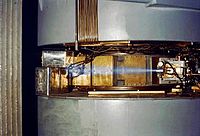
Photo from wikipedia
BACKGROUND While few studies analysed the diagnostic validity of preoperative radiographs in distinguishing between Vancouver type B1 and B2 periprosthetic femoral fractures (PFFs), no investigation has been conducted to assess… Click to show full abstract
BACKGROUND While few studies analysed the diagnostic validity of preoperative radiographs in distinguishing between Vancouver type B1 and B2 periprosthetic femoral fractures (PFFs), no investigation has been conducted to assess the degree of diagnostic validity of preoperative radiographs in identifying the fracture course and planning the most appropriate treatment. We analysed the diagnostic validity of radiographs in detecting the fracture course and stem stability in Vancouver type B PFFs. METHODS Vancouver type B PFFs with different fracture courses were randomly performed in 36 dried cadaveric femurs in which a femoral broach had previously been implanted. Radiographic images, taken in the coronal and sagittal views, were analysed by 5 orthopaedic surgeons and 2 radiologists who were asked to reproduce the fracture course and to evaluate stem stability. A scoring system was used to determine the injured femoral cortex correctly identified by the examiners. RESULTS The identification of the fracture course was scored as poor in 52.4% and 56.%, fair in 23% and 23.4% and good in 24.6% and 19.8%, The identification of the fracture course in the coronal and axial vies radiographs was scored in coronal and axial view radiographs respectively. There was no significant difference in the average score obtained by senior and young examiners. In the coronal plane, the fracture course was poorly identified by all examiners in 11 (30.5%) femurs and by 5 or more examiners in 17 (47%). The fracture course was correctly identified by 5 or more examiners in 8 femurs (22%). A vertical fracture involving an emidiaphysis was found in 8 of the 11 femurs in which the PFF was poorly diagnosed by all examiners. Stem instability was correctly diagnosed in 45% of cases. CONCLUSIONS In type B PFFs preoperative radiographs show a reduced diagnostic validity in identifying the fracture course and, hence, in planning a correct treatment. Potentially unstable vertical fractures involving an emidiaphysis are likely to be poorly diagnosed since most of the fracture course is hidden by the femoral stem. In cementless stems the diagnostic validity of radiographs in diagnosing between Vancouver type B1 and B2 seems to be lower than that reported for cemented stems.
Journal Title: Injury
Year Published: 2020
Link to full text (if available)
Share on Social Media: Sign Up to like & get
recommendations!